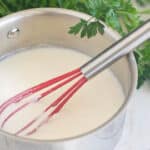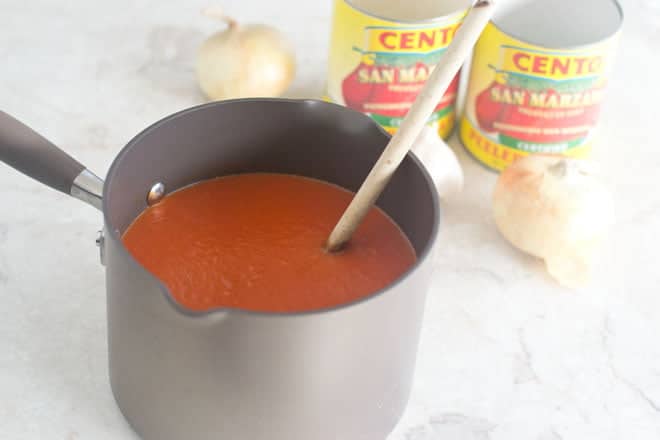Learn how to make the classic French béchamel with tips for making it perfectly, from the ratios of flour to butter to milk to how to store it and more. Getting it down will make you a master in the kitchen.
Béchamel sauce is a classic. It’s called one of the French Mother Sauces because it’s so basic and because it’s a starting place for so many things from Mac ‘n’ Cheese to soufflés to lasagna.
Don’t get scared off by the fact that it’s French and “classic” though. One of the interesting thing about French cooking is that it’s all about simple things, at least to start. I’m even betting that you’ve probably made béchamel or one of it’s variations before without even knowing it.

What Is Béchamel Sauce?
It’s a very simple white sauce that only has three required ingredients: Butter, flour, and milk. Salt, black pepper or white pepper, and/or nutmeg are often added to the sauce as well. It’s completely white in color. It can be thick or thin depending on the ratio of butter, flour, and milk used (more on the ratio later).
What Is Béchamel Used For?
If ever you’ve made homemade macaroni and cheese, you’ve probably made a béchamel. Actually, béchamel is the beginning of so many dishes and other sauces that you’ve possibly made it tons of times.
- In addition to macaroni and cheese, béchamel is the white sauce sometimes found as one of the layers in lasagna.
- Soups with the title “cream of” as in “cream of mushroom soup” often start with a béchamel that is then thinned a lot more with milk as other ingredients are added.
- A very thick béchamel is used as the start of soufflés and of the Greek dish Moussaka.
- Mornay sauce is a basic béchamel with grated Gruyere cheese added to it. Or, add sharp Cheddar cheese to make the best cheese sauce ever, like in this recipe.
- Béchamel is also used in gratin dishes, sometimes in the American scalloped potatoes.
- It’s also a great sauce to use as a substitute for canned condensed soups in those old casserole recipes that some of us grew up with (tuna casserole, I’m looking at you!).
- A basic béchamel can also be used as the start of a gravy. You can make this simple white sauce while your roast cooks. Then add drippings from the roast after it’s done. Or, use bacon fat instead of butter to make this luscious Bacon Gravy.
- Or add black pepper and cooked ground sausage for a sausage gravy to pour over biscuits.
- Serve over baked chicken and sprinkle with fresh parsley to elevate a simple dinner.
Is Bechamel Sauce The Same As Alfredo Sauce?
No. While they look almost the same, alfredo has the addition of Parmesan cheese. (And in fact, a traditional alfredo sauce doesn’t have the milk or flour.)
How To Make Béchamel Sauce
Béchamel consists of butter, flour, and milk. It’s the method of combining them that makes them into a sauce though.
- First, put your butter into a saucepan over medium heat just until it’s melted. You don’t want it to brown at all.
- Then add flour to the melted butter. Whisk it into a paste, called a roux. I like highly recommend using a flat whisk like this one because it can really get into every corner and cranny of your pot (truly, if you get a whisk like this, it will become your go-to tool. I use mine for everything and almost never pull out my balloon whisk since getting it).
- Cook the roux for 1 minute while whisking continuously. This cooking step is important because this is where the raw flour taste gets cooked out of the flour.
- Remove the paste from the heat and dribble in the milk. Start by adding about 2 tablespoons of milk. Whisk until smooth. Add another 2 tablespoons and whisk again. Keep going, dribbling a bit of milk at a time, keeping it smooth after each addition. You’ll find that as more milk is added, it’s easier to add more at a time and still get the mixture smooth. Going slowly the first few times until you get the hang of it is the way to go.
- Put the pot back onto the heat and heat it until it reaches a simmer, stirring the whole time. Simmer it while stirring for 1 minute.
- Remove from heat and season to taste with salt, white or black pepper and, optionally, nutmeg.
The Ratios of Butter, Flour, and Milk
The thing that adds thickness to a béchamel is the flour. More flour leads to a thicker sauce, less flour to a thinner sauce. The butter is in the sauce as a way to help disperse the flour without creating lumps. It also adds richness to the sauce.
You almost always use equal amounts of butter and flour in a béchamel. These ingredients are whisked into a paste, cooked and then milk is slowly whisked in. How much of each do you use?
If you’re making a béchamel as a simple sauce (thickened but definitely pourable), the most basic ratio is 1 and 1/2 tablespoons of butter to 1 and 1/2 tablespoons of flour for each cup of milk.
If you’re making a cheese sauce, like for a Mornay sauce or for Mac ‘n’ Cheese, the cheese is going to act as an extra thickener so the sauce itself can start out thinner. Go with 1 tablespoon each of butter and flour per cup of milk.
If you want a really thick sauce, like for the start of a soufflé, for Moussaka, and sometimes for lasagna (I don’t make my lasagna béchamel this thick but some people do), you can go with as much as 3 tablespoons of butter and flour for each cup of milk.
I find it better to err on the side of making a too-thick sauce because you can always thin it with more milk to get the desired consistency. If you instead start with a lower amount of butter and flour and then discover that your resulting sauce is too thin, it’s harder to thicken it. If that happens you need to start over and make an extra-thick sauce and then add your too-thin sauce to it. Whisk them together and you’ll get a sauce halfway between the two.
The amount of sauce that you will end up with in the end is just about equivalent to the amount of milk that you use since the flour and butter are never a significant factor. If you use 1 cup of milk in the recipe, you’ll have a little bit more than 1 cup of sauce once it’s ready.
Storing Béchamel Sauce
If you’re not using the sauce immediately, you can keep it to use later in one of two ways.
First, let it cool to room temperature. Stir the sauce. Then…
Refrigerate béchamel: Take a piece of plastic wrap and push it onto the surface of the sauce. This prevents a skin from forming. Refrigerate for up to 3 days. Reheat slowly on the stove, stirring often. Or reheat it in the microwave, 30 seconds at a time, stirring after each interval.
Freeze béchamel: Transfer it to a freezer container. Make sure the container is well-sealed. Freeze for up to 1 month. Let it defrost overnight in the fridge. Reheat slowly on the stove while stirring continuously. Note that this sauce can separate from freezing. Stirring constantly as it heats helps it to stay together. However, if you have frozen béchamel and you want to use up, you’re best to plan for it to be mixed into dishes (where the potential separation will be less noticeable) than in a dish where the sauce is meant to be noticeable and look pretty.
More Delicious Sauce Recipes
I’m a big believer that a great sauce can truly transform a meal. If you agree, here are all of my delicious sauce recipes for you to browse through. And, here are some of my favorites to inspire you:
- Homemade Cocktail Sauce
- The Best Gravy Recipe
- Horseradish Sauce (especially good on Prime Rib!)
- Garlic Butter Sauce
- Homemade Tartar Sauce
Podcast Episode: Making Bechamel Sauce
Listen to me explain briefly about how to make this sauce, along with some other great tips, by clicking the play button below:
Listen to more Recipe of the Day episodes here.
Print
Béchamel Sauce Recipe
- Prep Time: 5 minutes
- Cook Time: 15 minutes
- Total Time: 20 minutes
- Yield: 2 cups 1x
- Category: Sauce
- Method: Stovetop
- Cuisine: French
DESCRIPTION
This classic sauce is used in many things, from Mac ‘n’ Cheese to souffles to lasagna. Getting it down will make you a master in the kitchen.
Ingredients
- 3 Tbsp. unsalted butter
- 3 Tbsp. all-purpose flour
- 2 cups whole milk
- Salt (optional but recommended)
- White or black pepper (optional)
- Pinch of grated nutmeg (optional)
Instructions
- In a medium saucepan, melt the butter over medium heat. Add the flour and whisk together to form a paste. Cook for 1 minute while whisking continuously. Remove from the heat.
- Add 1/4 cup of the milk and whisk until smooth. Repeat adding a little bit of milk at a time, whisking until smooth with each addition, until all of the milk is added. Increase heat to medium-high and bring to a boil while whisking constantly. Let simmer one minute and then take off the heat.
- Season with salt, pepper, and nutmeg to taste or as desired.
Love this recipe? I’d appreciate it if you could scroll down and add a *5 star rating* to help others know they’ll love it as well!
This post originally appeared in February 2017 and was revised and republished in March 2022.

























I recently subscribed to your site.
ALL your recipes are excellent 💛
Deb, thank you so much! That means a lot to me to hear. Have a great day!
It is the mother sauce. I have been making it in various forms for over 40 years. I always use half and half and add wine. It starts with a basic rue, I have made it very thick for turkey croquettes it will bind, much thinner for mac and cheese, turkey tetrazzini, green bean casserole, the list is endless. I can actually just melt butter and toss flour in by sight, but 40 plus years gives you that skill. I realize its counter productive but it is fantastic in cauliflower alfredo or just alfredo. With the basic sauce you can begin throwing anything into it, garlic, cheeses, and mushrooms, my favorites. One hint when using it to make casseroles that you will bake and freeze keep it thinner. Cooked in casseroles it freezes extremely well , doesn’t separate, but might be a bit dry when reheating.
Thanks for sharing your experiences with us!
I have hunted for the RATIO info on Bechamel. Thank So so much. They way you explained has answered every question that has frustrates me every time I give it a try. Your hints and tips…….well Thank You. I love to cook and I’m not to bad sometimes but I could NEVER figure out the BECHAMEL! Gotta ho now, on my way to go make some amazing sauces and gravies. God Bless You.
Happy cooking, Kris! So glad we could be helpful!
Yummy! It is the mother sauce!